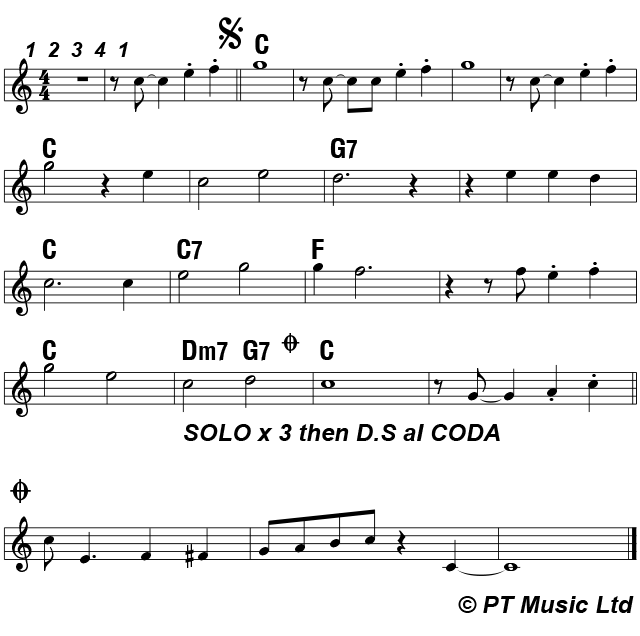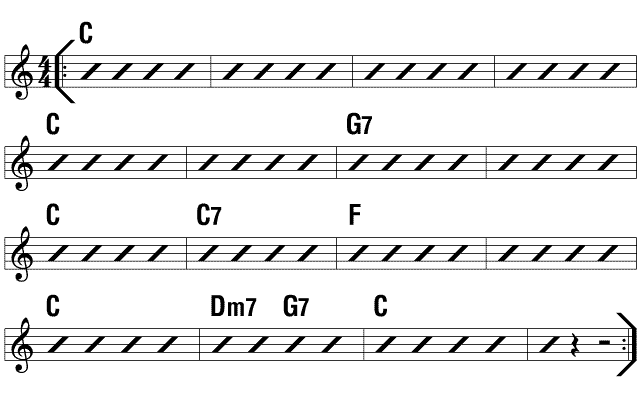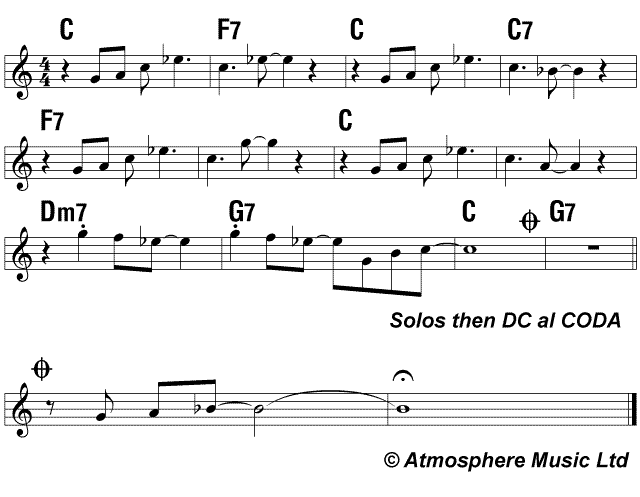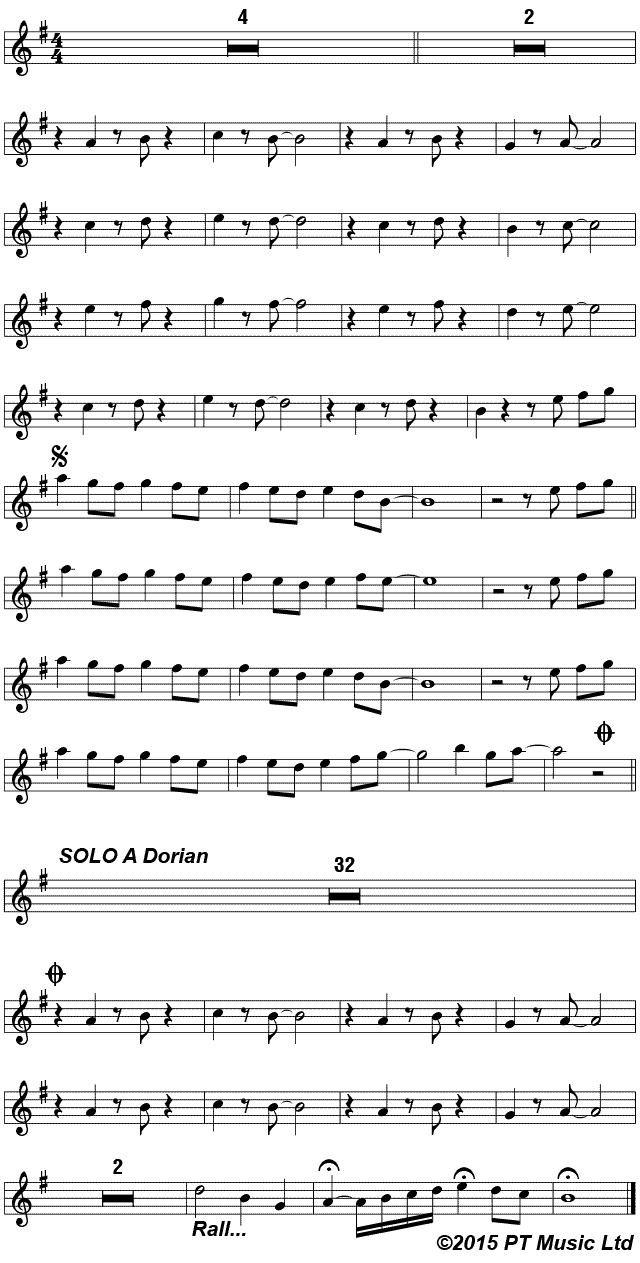Ooh Ah Ooh (2 Chords)
This tune is a typical two chord tune that uses chord I and V7 in a short 8 bar sequence. This is a common form which you can hear in songs such as All About That Bass, Jambalaya, Iko Iko, Sea Cruise and many others.
This has a very slightly different format as it starts on the V7 chord. This is a great way to get used to playing a very important chord change from V7 to I. In music theory this is called a perfect cadence, you can think of it like the returning home part of a journey. We know that we can think of the I or tonic chord of a key as “home”. Various other chords can feel like we are away on a journey, but the V7 can specifically make us feel like we are a bit homesick and need to get home. Listen to the tune first and you will here what we mean by this.
You can have a lot of fun with this – there is a two bar break which you can fill however you like. There is no backing to this bit apart from a quiet count to help you keep time so experiment in the breaks as whatever you play can’t clash and sound wrong against the backing.
As always, first of all familiarise yourself with the main chord tones. As this is a very simple tune, the I chord works well as a triad, but there is no harm in considering the 6th or major 7th as chord tones.
As well as a melodic improvised solo, it is a good idea to practice playing riffs. Included is an example of riffing over the sequence. Not that riffs can either follow the chord root exactly or repeat but with slightly different notes to fit the chords. See blues riffs and licks
Ooh Ah Ooh Example Solo – Alto
Ooh Ah Ooh Example Solo – Tenor
Alto

Tenor

Sand Dance
Every now and again a friend of mine brings their son or daughter (who is learning the saxophone at school) round, and of course they are asked to play for me, which is probably as awkward for me as it is for them because I’m expected to give a critique. I ask them what tunes they know and they seem to only have tunes from their grade 1 or 2 which they find very boring. Beginners tunes should be fun and entertaining as well as easy.
So I teach them this tune, and they love it. Everybody knows this tune, but not many people know what it’s called, apart from “The Snake Charming Tune”. Actually it is not played by real snake charmers, neither is it even middle eastern in origin. It has had several titles, but this I call this version Sand Dance.
The Harmonic Minor
As you know there are many variants on the minor scale, and up to now we have just looked at the natural minor. Another very useful minor scale is the harmonic minor. This has a slightly “exotic” sound to it so works very well with this tune which has a sort of “fake” middle Eastern feel.
It also fits well because the V chord is a dominant rather than being another minor chord. (see the chord slider)
Alto slider
Tenor slider
In this arrangement I have used only two chords:
Alto: Am and E7
Tenor: Dm and A7.
The final note has a pause (aka fermata) and there is plenty of time to play a little cadenza if you want: just play the key scale of bits of the key scale in free time. This is a fun tune and you can make the most of it by adding some vibrato, note bends or any kind of ornament. Don’t worry about is sounding corny, the tune itself is corny!
Alto

Tenor

The Saints
Oh When the Saints Go Marching In is a famous tune everybody must know and is ideal for that moment when you are asked “come on, play us a tune then!”
Eveyone knows this tunes, especially if you support any of the many sports teams that go by the name The Saints (e.g. Football teans Southampton FC & New Orleans).
I have simplified this version in some respects. Very often the IV chord at bar 11 changes to a minor. In this version, which as a New Orleans rock and roll feel, that chord stays as a major chord. It can work well to strive for a raucous edgy tone, add some vibrato or growl as an effect and to “push the beat,” which means sometimes playing very slightly ahead of the actual beat.
However in the example solo we have also added something new: blue notes. You will notice some G#s and Abs. These sound as the same note of course, but are written differently to make them easier to read in different contexts (often G# ascending and Ab descending)
There will be more about this when we look at some 12 bar blues tunes. In practical terms, it means we can flatten certain notes, often called blue notes. In this case we are flattening the 3rd of the key scale (which is the same as 7th of chord IV).
Alto

Chords

Tenor

Chords

Slinky
This is a nice comfortable tempo simple jazz blues. Playing the blues is not as simple as many people suspect. Although we can use just one key scale, the one scale that will (most times) be OK is a minor type scale, e.g the minor pentatonic or minor blues scale which is the same but with an added passing note.
In the example solo you will hear that I use the minor a lot, but there are one or two major 3rds to add some variety. These can work very well, but you must be careful where you use them.
A simple rule is that you can use the minor pentatonic or blues scale throughout, but for added interest you can also use major 3rds on wherever there is chord I.
Scale for alto

Scale for tenor

Alto

Chords

Tenor

Chords

Doreen a là Mode
This is as close as we get to jazz in this section, this is in the style of 1960s modal jazz which became popular in the late 1950s and 1960s. perhaps it was a backlash against the complexity of bebop.
In this type of jazz there is often only one chord, or a vamp, which can last for a long time. We are not going to modes in too much detail here, you can read about them on the Modes in Improvisation Article. In this context we think of a mode as being a scale which appears to be the same as a normal major scale, but starting on and having a different note as its “home.” In this case we are looking at one of the most common in many popular styles, the Dorian. It is like a major scale, but starting on the second degree, so a D Dorian has the same notes as C major. (You may already have noticed that the natural minor is a mode – it is in fact the Aeolian and has the same notes as a major scale but based around the sixth degree.)
The great thing about this is that (as with the Gorilla vamp exercises) we do not even have to think about chord changes, we just concentrate on using the scale to make some interesting melodic improvising. You may notice that the piano is playing more than one chord, but you needn’t worry about following them, because the bass line is implying just one root (around a C in concert pitch)
First of all you can try just running up and down the scale, or use shorter sections, to get used to it. However after a while you should be able to jump between the notes. You don’t have to stick exactly to the dorian mode, you’ll find that a pentatonic or blues scale will also fit nicely.
For Eb instruments the scale is A Dorian = A B C D E F# G A
For Bb instruments the scale is D Dorian = D E F G A B C D
(NB: to be edited. Intro = 1 x vamp and 2 bar drum break)
Alto

Tenor

Jumpin Blues
This is a blues in a “jump” style. As with Slinky we can use just one key scale, e.g the minor pentatonic or minor blues scale which is the same but with an added passing note.
Again, if you feel like it you can add major 3rds to add some variety. These can work very well, but you must be careful where you use them so to begin with just use the minor scales.
On alto:

On tenor:

Alto

Tenor








